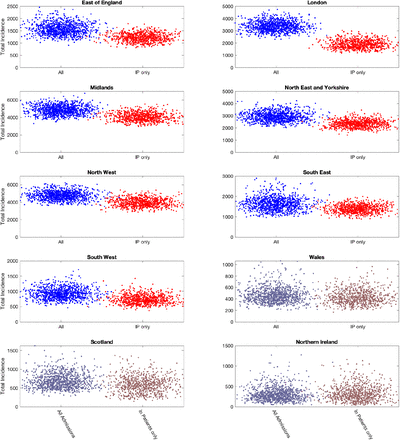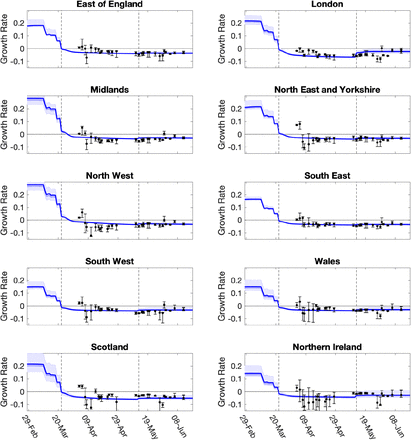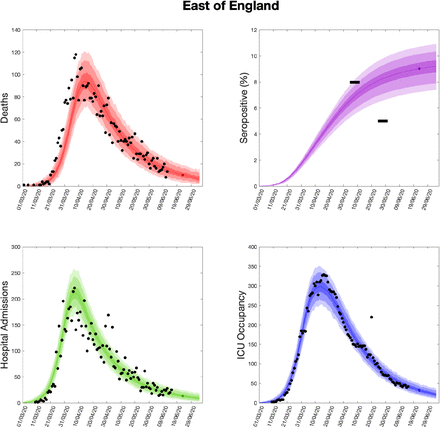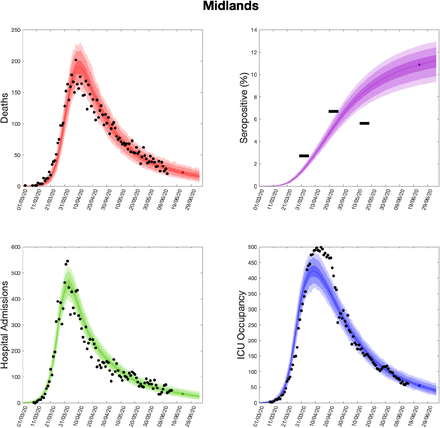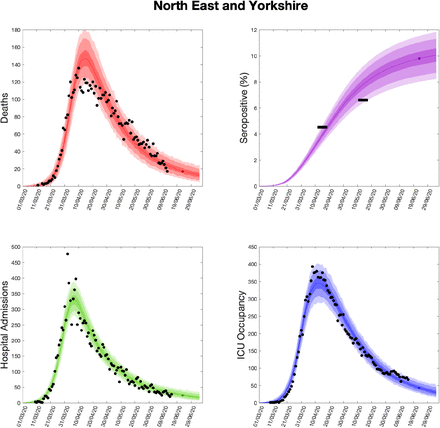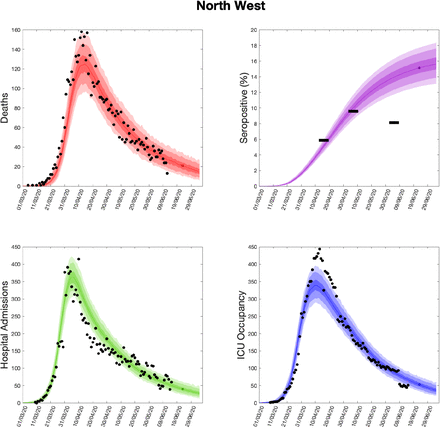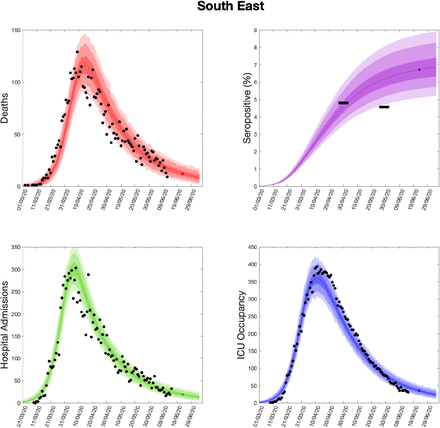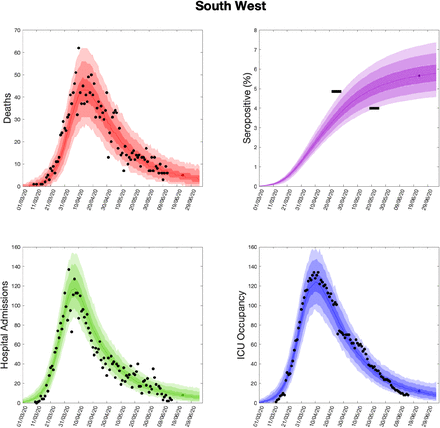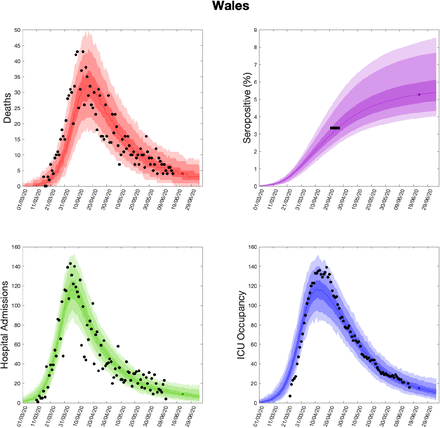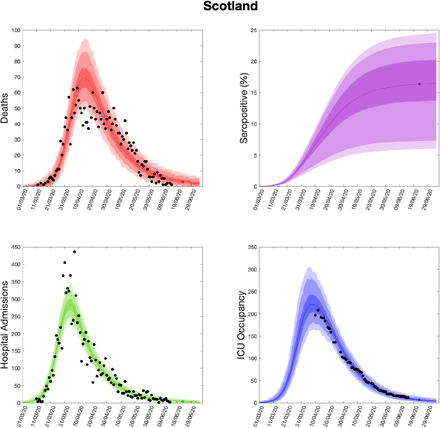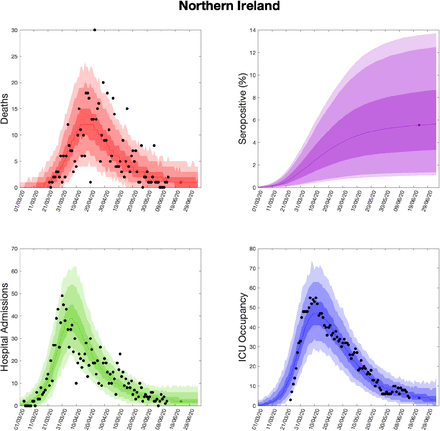Abstract
The COVID-19 pandemic has brought to the fore the need for policy makers to receive timely and ongoing scientific guidance in response to this recently emerged human infectious disease. Fitting mathematical models of infectious disease transmission to the available epidemiological data provides a key statistical tool for understanding the many quantities of interest that are not explicit in the underlying epidemiological data streams. Of these, the basic reproductive ratio, R, has taken on special significance in terms of the general understanding of whether the epidemic is under control (R < 1). Unfortunately, none of the epidemiological data streams are designed for modelling, hence assimilating information from multiple (often changing) sources of data is a major challenge that is particularly stark in novel disease outbreaks.
Here, focusing on the dynamics of the first-wave (March-June 2020), we present in some detail the inference scheme employed for calibrating the Warwick COVID-19 model to the available public health data streams, which span hospitalisations, critical care occupancy, mortality and serological testing. We then perform computational simulations, making use of the acquired parameter posterior distributions, to assess how the accuracy of short-term predictions varied over the timecourse of the outbreak. To conclude, we compare how refinements to data streams and model structure impact estimates of epidemiological measures, including the estimated growth rate and daily incidence.
1 Introduction
In late 2019, accounts emerged from Wuhan city in China of a virus of unknown origin that was leading to a cluster of pneumonia cases [1]. The virus was identified as a novel strain of coronavirus on 7th January 2020 [2], subsequently named Severe Acute Respiratory Syndrome Coronavirus (SARS-CoV-2), causing the respiratory syndrome known as COVID-19. The outbreak has since developed into a global pandemic. As of 3rd August 2020 the number of confirmed COVID-19 cases is approaching 18 million, with more than 685,000 deaths occurring worldwide [3]. Faced with these threats, there is a need for robust predictive models that can help policy makers by quantifying the impact of a range of potential responses. However, as is often stated, models are only as good as the data that underpins them; it is therefore important to examine, in some detail, the parameter inference methods and agreement between model predictions and data.
In the UK, the first cases of COVID-19 were reported on 31st January 2020 in the city of York. Cases continued to be reported sporadically throughout February and by the end of the month guidance was issued stating that travellers from the high-risk epidemic hotspots of Hubei province in China, Iran and South Korea should self-isolate upon arrival in the UK. By mid-March, as the number of cases began to rise, there was advice against all non-essential travel and, over the coming days, several social-distancing measures were introduced including the closing of schools, non-essential shops, pubs and restaurants. This culminated in the introduction of a UK lockdown, announced on the evening of 23rd March, whereby the public were instructed to remain at home with four exceptions: shopping for essentials; any medical emergency; for one form of exercise per day; and to travel to work if absolutely necessary. By mid-April, these stringent mitigation strategies began to have an effect, as the number of confirmed cases and deaths as a result of the disease began to decline. As the number of daily confirmed cases continued to decline during April, May and into June, measures to ease lockdown restrictions began, with the re-opening of some non-essential businesses and allowing small groups of individuals from different households to meet up outdoors, whilst maintaining social distancing. This was followed by gradually re-opening primary schools in England from 1st June and all non-essential retail outlets from 15th June. Predictive models for the UK are therefore faced with a changing set of behaviours against which historic data must be judged, and an uncertain future of potential additional relaxations.
Throughout, a significant factor in the decision-making process was the value of the effective reproduction number, R of the epidemic; this quantity was estimated by several modelling groups that provided advice through the Scientific Pandemic Influenza Modelling Group (SPI-M) [4]. The Warwick COVID-19 model presented here provided one source of R estimates through SPI-M. When R is estimated to be significantly below one, such that the epidemic is exponentially declining, then there is scope for some relaxation of intervention measures. However, as Rt approaches one, further relaxation of control may lead to cases starting to rise again. It is therefore crucial that models continue to be fitted to the latest epidemiological data in order for them to provide the most robust information regarding the impact of any relaxation policy and the effect upon the value of Rt. It is important to note, however, that there will necessarily be a delay between any change in behaviour, the epidemiological impact and the ability of an statistical method to detect this change.
The initial understanding of key epidemiological characteristics for a newly emergent infectious disease is, by its very nature of being novel, extremely limited and often biased towards early severe cases. Developing models of infectious disease dynamics enables us to challenge and improve our mechanistic understanding of the underlying epidemiological processes based on a variety of data sources. One way such insights can be garnered is through model fitting / parameter inference, the process of estimating the parameters of the mathematical model from data. The task of fitting a model to data is often challenging, partly due to the necessary complexity of the model in use, but also because of data limitations and the need to assimilate information from multiple sources of data [5].
Throughout this work, the process of model fitting is performed under a Bayesian paradigm, where model parameters are assumed to be random variables and have joint probability distributions [6]. These probability distributions quantify uncertainty in the model parameters, which can be translated into uncertainty in model predictions. We take a likelihood-based approach, in which we define the likelihood (the probability of observing the data given a particular model and parameter set) and use the likelihood to find the probability distribution of our model parameters. In particular, we use Markov Chain Monte Carlo (MCMC) schemes to find the posterior probability distribution of our parameter set given the data and our prior beliefs. MCMC methods construct a Markov chain which converges to the desired posterior parameter distribution at steady state [7]. Simulating this Markov chain thus allows us to draw sets of parameters from the joint posterior distribution.
As stated above, the parameter uncertainty may then be propagated if using the model to make projections. This affords models with mechanistic aspects, through computational simulation, the capability of providing an estimated range of predicted possibilities given the evidence presently available. Thus, models can demonstrate important principles about outbreaks [8], with examples during the present pandemic including analyses of the effect of non-pharmaceutical interventions on curbing the outbreak of COVID-19 in the UK [9].
In this paper, we present the inference scheme, and its subsequent refinements, employed for calibrating the Warwick COVID-19 model [10] to the available public health data streams and estimating key epidemiological quantities such as R. In particular it is worth stressing that throughout we present our approach as it evolved during the outbreak, rather than the optimal methods and assumptions that would be made with hindsight.
We begin by describing our mechanistic transmission model for SARS-CoV-2 in section 2, detailing in section 3 how the effects of social distancing are incorporated within the model framework. In order to fit the model to data streams pertaining to critical care, such as hospital admissions and bed occupancy, section 4 expresses how epidemiological outcomes were mapped onto these quantities. In section 5, we outline how these components are incorporated into the likelihood function and the adopted MCMC scheme. The estimated parameters are then used to measure epidemiological measures of interest, such as the growth rate (r), with the approach detailed in section 6.
The closing sections draw attention to how model frameworks may evolve during the course of a disease outbreak as more data streams become available and we collectively gain a better understanding of the epidemiology (section 7). We explore how key epidemiological quantities, in particular the reproduction number R and the growth rate r, depend on the data sources used to underpin the dynamics (section 8). To finish, we outline the latest fits and model generated estimates using data up to mid-June (section 9).
2 Model description
We present here the system of equations that account for the transmission dynamics, including symptomatic and asymptomatic transmission, household saturation of transmission and household quarantining. The population is stratified into multiple compartments: individuals may be susceptible (S), exposed (E), with detectable infection (symptomatic D), or undetectable infection (asymptomatic, U). Undetectable infections are assumed to transmit infection at a reduced rate given by τ. We let superscripts denote the first infection in a household (F), a subsequent infection from a detectable/symptomatic household member (SD) and a subsequent infection from an asymptomatic household member (SU). A fraction (H) of the first detected case in a household is quarantined (QF), as are all their subsequent household infections (QS) - we ignore the impact of household quarantining on the susceptible population as the number in quarantine is assumed small compared with the rest of the population. The recovered class is not explicitly modelled, although it may become important once we have a better understanding of the duration of immunity. Natural demography and disease-induced mortality are ignored in the formulation of the epidemiological dynamics.
Model equations
The full equations are given by
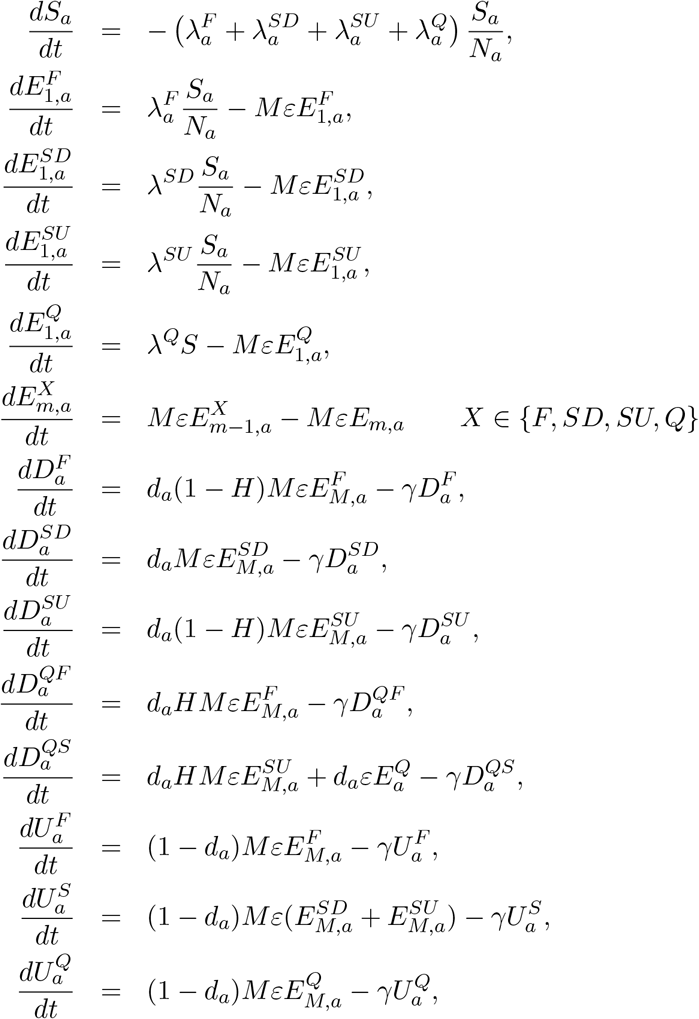
Here we have included M latent classes, giving rise to a Erlang distribution for the latent period, while the infectious period is exponentially distributed. The forces of infection which govern the non-linear transmission of infection obey:
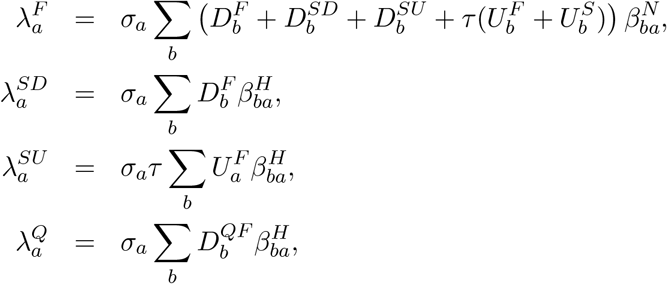 where βH represents household transmission and βN = βS + βW + βO represents all other transmission locations, comprising school-based transmission (βS), work-place transmission (βW) and transmission in all other locations (βO). These matrices are taken from Prem et al [11], although other sources such as POLYMOD [12] could be used. σa corresponds to the age-dependent susceptibility of individuals to infection, da the age-dependent probability of displaying symptoms (and hence being detected), and τ represents reduced transmission of infection by undetectable individuals compared to detectable infections.
where βH represents household transmission and βN = βS + βW + βO represents all other transmission locations, comprising school-based transmission (βS), work-place transmission (βW) and transmission in all other locations (βO). These matrices are taken from Prem et al [11], although other sources such as POLYMOD [12] could be used. σa corresponds to the age-dependent susceptibility of individuals to infection, da the age-dependent probability of displaying symptoms (and hence being detected), and τ represents reduced transmission of infection by undetectable individuals compared to detectable infections.
Amendments to within-household transmission
We wanted our model to be able to capture both individual level quarantining and isolation of households with identified cases. In an standard ODE framework this level of household structure is only achievable at large computational expense [13, 14], so instead we make a number of approximation to achieve a comparable effect.
We make the simplification that all within household transmission originates from the first infected individual within the household (denoted with a superscript F or QF is they quarantine). This allows us to assume that secondary infections within a household in isolation (denoted with a superscript QS or Q) play no further role in the transmission dynamics. This means that high levels of household isolation can drive the epidemic extinct, as only the first individual infected in each household can generate infections outside the household. This methodology also helps to capture to some degree household depletion of susceptibles (or saturation of infection), as secondary infections in the household are not able to generate additional household infections. Adopting this formulation naturally leads to a reduction in total onward transmission compared with a model where such household effects is ignored - this is because we have truncated within household transmission. We find that a simple multiplicative scaling to the household transmission (βH → zβH, z ≈ 1.3) generates a close match between the new model and one in which saturation effects are ignored, and we therefore include this scaling within the full model.
Key Model Parameters
As with any model of this complexity, there are multiple parameters that determine the dynamics. Some of these are global parameters and apply for all geographical regions, with others used to capture the regional dynamics. Some of these parameters are fitted to the early outbreak and other data (table 1), however the majority are inferred by the MCMC process (table 2).
Description of key model parameters not fitted in the MCMC and their source
Description of key model parameters fitted in the MCMC
Relationship between age-dependent susceptibility and detectability
We interlink age-dependent susceptibility, σa, and detectability, da, by a quantity Qa. Qa can be viewed as the scaling between force of infection and symptomatic infection. Taking a next-generation approach, the early dynamics would be specified by:
 where Da measures those with detectable infections, which mirrors the early recorded age distribution of symptomatic cases. Explicitly, we let
where Da measures those with detectable infections, which mirrors the early recorded age distribution of symptomatic cases. Explicitly, we let  and
and  . As a consequence, Qa = κkdaσa; where the parameters κ and k are determined such that the oldest age groups have a 90% probability of being symptomatic (d>90 = 0.90) and such that the basic reproductive ratio from these calculations gives R0 = 2.7.
. As a consequence, Qa = κkdaσa; where the parameters κ and k are determined such that the oldest age groups have a 90% probability of being symptomatic (d>90 = 0.90) and such that the basic reproductive ratio from these calculations gives R0 = 2.7.
Throughout much of our work with this model, the values of α and τ are key in determining behaviour - in particular the role of school children in transmission [15]. We argue that a low τ and a low α are the only combination that are consistent with the growing body of data suggesting that levels of seroprevalence show only moderate variation across age-ranges [16], yet children do not appear to play a major role in transmission [17, 18]. To some extent, the separation into symptomatic (D) and asymptomatic (U) within the model is somewhat artificial as there are a wide spectrum of symptom severity that can be experienced.
Regional Heterogeneity in the Dynamics
Throughout the current epidemic, there has been noticeable heterogeneity between the different regions of England and between the devolved nations. In particular, London is observed to have a large proportion of early cases and a relatively steeper decline in the subsequent lock-down than the other regions and the devolved nations. In our model this heterogeneity is captured through three regional parameters which act on the heterogeneous population pyramid of each region.
Firstly, the initial level of infection in the region is re-scaled from the early age-distribution of cases, with the regional scaling factor set by the MCMC process. Secondly, we allow the age-dependent susceptibility to be scaled between regions (scaling factor IR) to account for different levels of social mixing and hence differences in the early R0 value. Finally, the relative strength of the lockdown (which may be time-varying) is again regional and is determined by the MCMC process.
3 Modelling social distancing
Age-structured contact matrices for the United Kingdom were obtained from Prem et al. [11] and used to provide information on household transmission ( with the subscript ab corresponding to transmission from age group a against age group b), school-based transmission
with the subscript ab corresponding to transmission from age group a against age group b), school-based transmission  , work-place transmission
, work-place transmission  and transmission in all other locations
and transmission in all other locations  . We assumed that the suite of social-distancing and lockdown measures acted in concert to reduce the work, school and other matrices while increasing the strength of household contacts.
. We assumed that the suite of social-distancing and lockdown measures acted in concert to reduce the work, school and other matrices while increasing the strength of household contacts.
We capture the impact of social-distancing by defining new transmission matrices (Ba,b) that represent the potential transmission in the presence of extreme lockdown. In particular, we assume that:
 while household mixing BH is increased by up to a quarter to account for the greater time spent at home. We take qS = 0.05, qW = 0.2 and qO = 0.05 to approximate the reduction in attendance at school, attendance at workplaces and engagement with shopping and leisure activities during the lock-down, respectively.
while household mixing BH is increased by up to a quarter to account for the greater time spent at home. We take qS = 0.05, qW = 0.2 and qO = 0.05 to approximate the reduction in attendance at school, attendance at workplaces and engagement with shopping and leisure activities during the lock-down, respectively.
For a given compliance level, ϕ, we generate new transmission matrices as follows:

As such, home and school interactions are scaled between their pre-lockdown values (β) and post-lockdown limits (B) by the scaling parameter ϕ. Work interactions that are not in public-facing ‘industries’ (a proportion 1 - θ) were also assumed to scale in this manner; while those that interact with the general populations (such as shop-workers) were assumed to scale as both a function of their reduction and the reduction of others. We have assumed θ = 0.3 throughout. Similarly, the reduction in transmission in other settings (generally shopping and leisure) has been assumed to scale with the reduction in activity of both members of any interaction, giving rise to a squared term.
4 Public Health Measurable Quantities
The main model equations focus on the epidemiological dynamics, allowing us to compute the number of symptomatic and asymptomatic infectious individuals over time. However, these quantities are not measured - and even the number of confirmed cases (the closest measure to symptomatic infections) is highly biased by the testing protocols at any given point in time. It is therefore necessary to convert infection estimates into quantities of interest that can be compared to data. We considered six such quantities which we calculated from the number of newly detectable symptomatic infections on a given day nDd.
Hospital Admissions: We assume that a fraction
 of detectable cases will be admitted into hospital after a delay q from the onset of symptoms. The delay, q, is drawn from a distribution
of detectable cases will be admitted into hospital after a delay q from the onset of symptoms. The delay, q, is drawn from a distribution  (note that
(note that  .) Hospital admissions on day d of age a are therefore given by
.) Hospital admissions on day d of age a are therefore given by

ICU Admissions: Similarly, a fraction
 of detectable cases will be admitted into ICU after a delay, drawn from a distribution
of detectable cases will be admitted into ICU after a delay, drawn from a distribution  which determines the time between the onset of symptoms and admission to ICU. ICU admissions on day d of age a are therefore given by
which determines the time between the onset of symptoms and admission to ICU. ICU admissions on day d of age a are therefore given by

Hospital Beds Occupied: Individuals admitted to hospital spend a variable number of days in hospital. We therefore define two weightings, which determine if someone admitted to hospital still occupies a hospital bed q days later
 and if someone admitted to ICU occupies a hospital bed on a normal ward q days later
and if someone admitted to ICU occupies a hospital bed on a normal ward q days later  . Hospital beds occupied on day d of age a are therefore given by
. Hospital beds occupied on day d of age a are therefore given by

ICU Beds Occupied: We similarly define
 as the probability that someone admitted to ICU is still occupying a bed in ICU q days later. ICU beds occupied on day d of age a are therefore given by
as the probability that someone admitted to ICU is still occupying a bed in ICU q days later. ICU beds occupied on day d of age a are therefore given by

Number of Deaths: The mortality ratio
 determines the probability that a hospitalised case of a given age, a, dies after a delay, q drawn from a distribution,
determines the probability that a hospitalised case of a given age, a, dies after a delay, q drawn from a distribution,  between hospitalisation and death. The number of deaths on day d of age a are therefore given by
between hospitalisation and death. The number of deaths on day d of age a are therefore given by

Proportion testing seropositive: Seropositivity is a function of time since the onset of symptoms; we therefore define an increasing sigmoidal function which determines the probability that someone who first displayed symptoms q days ago would generate a positive serology test from a blood sample. The shape of this sigmoidal function is matched to data from PHE, while the asymptote (the long-term sensitivity of the test, ST) is a free parameter determined by the MCMC. We match our age-dependent prediction against antibody seroprevalence from weekly blood donor samples from different regions of England (approximately 1000 samples per region) [19].
These nine distributions are all parameterised from individual patient data as recorded by the COVID-19 Hospitalisation in England Surveillance System (CHESS) [20], the ISARIC WHO Clinical Characterisation Protocol UK (CCP-UK) database sourced from the COVID-19 Clinical Information Network (CO-CIN) [21, 22], and the PHE sero-surveillance of blood donors [19]. CHESS data is used to define the probabilities of different outcomes  due to its greater number of records, while CCP-UK is used to generate the distribution of times
due to its greater number of records, while CCP-UK is used to generate the distribution of times  due to its greater detail (Figure S1).
due to its greater detail (Figure S1).
However, these distributions all represent a national average and do not therefore reflect regional differences. We therefore define regional scalings of the three key probabilities  and two additional parameters that can stretch (or contract) the distribution of times spent in hospital and ICU. These five regional parameters are necessary to get good agreement between key observations in all regions and may reflect both differences in risk groups (in addition to age) between regions or differences in how the data are recorded between devolved nations. We stress that these parameters do not (of themselves) influence the epidemiological dynamics, but do strongly influence how we fit to the evolving dynamics.
and two additional parameters that can stretch (or contract) the distribution of times spent in hospital and ICU. These five regional parameters are necessary to get good agreement between key observations in all regions and may reflect both differences in risk groups (in addition to age) between regions or differences in how the data are recorded between devolved nations. We stress that these parameters do not (of themselves) influence the epidemiological dynamics, but do strongly influence how we fit to the evolving dynamics.
5 Likelihood Function and the MCMC process
Multiple components form the likelihood function; most of which are based on a Poisson-likelihood. For brevity we define LP(n|x) = (n ln(x) − x) / log(n!) as the log of the probability of observing i given a Poisson distribution with mean x. Similarly LB(n|N, p) is the log of the binomial probability function. The log-likelihood function is then:
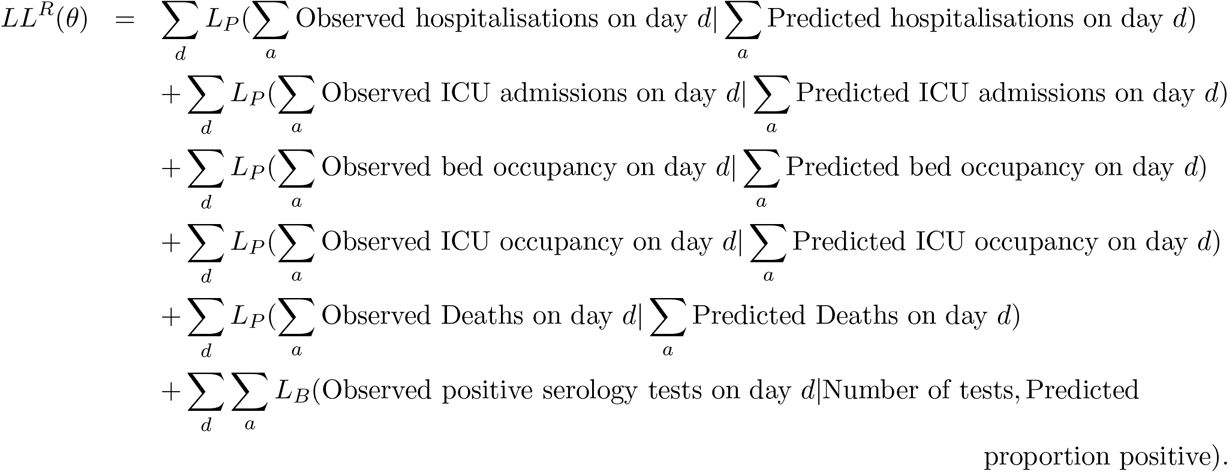
This log-likelihood is the key component of the MCMC scheme. In the MCMC process, we apply multiple updates of the parameters using normal or log-normal proposal distributions about the current values. Some parameters (the scaling of age-structure α, the relative transmission rate τ, the latent period 1/ε and the test sensitivity ST) are global and apply to all regions; new values of these are proposed and the log-likelihood calculated over all 10 regions. Other parameters are regional (such as the relative strength of lockdown restrictions ϕR) and can be updated for each region in turn, the ODEs simulated and stored. Finally, another set of regional parameters govern how the ODE output is translated into public health measurable quantities (section 4). These can be rapidly applied to the solution to the ODEs and the likelihood calculated. Given the speed of this last set, multiple proposals are tested for each ODE replicate.
New data are available on a daily time-scale, and therefore inference needs to be repeated on a similar time-scale. We can take advantage of this sequential refitting, by using the posteriors of one inference process as the initial conditions for the next, thus reducing the need for a long burn-in period.
6 Measuring the Growth Rate, r
The growth rate, r, is defined as the rate of exponential growth (r > 0) or decay (r < 0); and can be visualised as the gradient when plotting observables on a logarithmic scale. Figure 1 shows a simple example, whereby linear trends are fitted to the number of daily hospital admissions (per 100,000 people) in London. In this figure, three trend lines are plotted: one before lock-down; one during intense lock-down; and one after partial relaxation on 11th May. This plot clearly highlights the very different speeds between the initial rise and the long-term decline.
Points show the number of daily admissions to hospital (both in-patients testing positive and patients entering hospital following a positive test); results are plotted on a log scale. Three simple fits to the data are shown for pre-lockdown (red), strict-lockdown (blue) and relaxed-lockdown phases (green). Lines are linear fits to the logged data together with 95% confidence intervals, returning average growth rates of 0.21 (doubling every 3.4 days), −0.06 (halving every 11.5 days) and −0.02 (halving every 34 days).
While such statistically simple approaches are intuitively appealing, there are three main drawbacks. Firstly, they are not easily able to cope with the distributed delay between a change in policy (such as the introduction of the lockdown) and the impact of observable quantities (with the delay to deaths being multiple weeks). Secondly, they cannot readily utilise multiple data streams. Finally, they can only be used to extrapolate into the future - extending the period of exponential behaviour - they cannot predict the impact of further changes to policy. Our approach is to instead fit the ODE model to multiple data streams, and then use the daily incidence to calculate the growth rate. Since we use a deterministic set of ODEs, the instantaneous growth rate r can be calculated on a daily basis.
There has been a strong emphasis (especially in the UK) on the value of the reproductive number (R) which measures the expected number of secondary cases from an infectious individual in an evolving outbreak. R brings together both the observed epidemic dynamics and the time-frame of the infection, and is thus subject to uncertainties in the latent and infectious periods as well as in their distribution - although the growth rate and the reproductive number have to agree at the point r = 0 and R = 1. We have two separate methods for calculating R which have been found to be in very close numerical agreement. The first is to calculate R from the next generation matrix βba/γ using the current distribution of infection across age-classes and states. The second (and numerically simpler method) is to use the relationship between R and r for an SEIR-type model with multiple latent classes, which gives

7 An Evolving Model Framework
Unsurprisingly, the model framework has evolved during the epidemic as more data streams have become available and as we have gained a better understanding of the epidemiology. Early models were largely based on the data from Wuhan, and made relatively crude assumptions about the times from symptoms to hospitalisation and death. Later models incorporated more regional variation, while the PHE serology data in early May had a profound impact on model parameters.
Figure 2 shows how our short-term predictions (each of three-weeks duration) have changed over time, focusing on hospital admissions in London. It is clear that the early predictions were pessimistic about the reduction that would be generated by lockdown, although in part the higher values from early predictions is due to having identical parameters across all regions in the earliest models. In general later predictions, especially after the peak, are in far better agreement although the early inclusion of a step-change in the strength of the lockdown restrictions from 13th May (orange) led to substantial over-estimation of future hospital admissions. Across all regions we found some anomalous fits, which are due to changes in the way data were reported (figures S3 and S4).
For all daily hospital admissions with COVID-19 in London, we show the raw data (block dots) and a set of short-term predictions generated at different points during the outbreak, changes to model fit reflect both improvements in model structure as well as increased amounts of data. The intervals represent our confidence in the fitted ODE model, and do not account for either stochastic dynamics nor the observational distribution about the deterministic predictions - which would generate far wider intervals.
The comparison of models and data over time can be made more formal by considering the mean squared error across the three-week prediction period for each region (figure 3). We compare three time varying quantities: (i) the mean value of the public health observable (in this case hospital deaths) in each region; (ii) the mean error between this data and the posterior set of ODE model predictions predicting forwards for three weeks; (iii) the mean error between the data and a simple moving average across the three time points before and after the data point. The top left hand graph in figure 3) shows a clear linear relationship between the mean value and the error from the moving average, giving support to our assumption (in the likelihood function) that the data are reasonably approximated as Poisson distributed such that the variance and mean are equal. The other two graphs show how the error in the prediction has dropped over time from very high values for simulations in early April (when the impact of the lockdown was uncertain) to values in late May and June that are comparable with the error from the moving average.
Each dot represents a simulation date (colour-coded) and region. For a data stream xt and model replicates  (where i accounts for sampling across the posterior parameter values) we compute the mean
(where i accounts for sampling across the posterior parameter values) we compute the mean  ; the prediction error
; the prediction error  ; the moving average
; the moving average  ; and the moving average error
; and the moving average error  .
.
8 Choice of Parameters to Inform the Likelihood
The likelihood expression given above is an idealised measure, and depends on all the observed data streams being available and unbiased. Unfortunately, ICU admission data have not been available to date, and there are subtle differences in data streams between the devolved nations. An important question is therefore how key epidemiological quantities (and in particular the reproduction number R and the growth rate r) depend on the data sources used to underpin the dynamics.
In a high dimensional systems with different temporal lags (see Figure S1), there are inevitably different time-scales from when a change in policy or adherence occurs and when its impact is observed in key quantities. We briefly assess this problem in Figure 4, by introducing a change in the strength of lock-down restrictions (ϕ) and recording the subsequent rates of change of five key model parameters (infections, symptomatic cases, hospitalisations, admission to ICU and Deaths). Unsurprisingly, the impact of this change in restrictions takes the longest time to resolve in the mortality, taking around seven weeks to realise the true growth rate. Even measures which should be more immediate, such as the growth of symptomatic cases, take some time to settle to the theoretical growth rate given the high dimensionality of the age-structured model. This all strongly suggests that at best our estimates of r and hence R will not be able to rapidly detect changes to the underlying behaviour.
A change in the underlying restrictions occurs at time zero, taking the asymptotic growth rate r from ≈ −0:026 to ≈ +0:01. This change is reected in an increase in growth rate of five key epidemiological quantities, which reach the true theoretical growth rate at different times.
Figure 5 (left panel) shows the impact of using different observables for London (other regions are shown in Figure S5). Five different choices are shown: matching to recorded deaths only (using the date of death); matching to hospital admissions (both in-patients testing positive and admissions of individuals who have already tested positive); matching to bed occupancy, both hospital wards and ICU; matching to a combination of deaths and admissions; and finally matching to all data. In general we find that just using reported deaths produces the greatest spread of growth rates (r), presumably because deaths represent a small fraction of the total outbreak, and therefore naturally introduce more uncertainty. Using hospital admissions (with or without deaths) generates similar predictions and similar levels of uncertainty in predictions.
Here the growth rates are estimated using the predicted rate of change of new cases for London on 10th June 2020, with parameters inferred using data until 9th June. (a) The impact of restricting the inference to different data streams (deaths only, hospital admissions, hospital bed occupancy, deaths and admissions or all data); serology data was included in all inference. (b) The impact of having different numbers of lockdown phases (while using all the data); the default is three (as in Figure 1).
As mentioned in section 7, the number of phases used to describe the reduction in transmission due to lockdown has changed as the situation, model and data evolved. The model began with just two phases; before and after lockdown. However, in late May, following the policy changes on 13th May, we explored having three phases. Having three phases is equivalent to assuming the same level of adherence to the lockdown and social-distancing measures throughout the epidemic, with changes in transmission occurring only due to the changing policy on 23rd March and 13th May. However, different number of phases can be explored (figure 5, right panel). Moving to four phases (with two equally spaced within the more relaxed lockdown) increases the variation, but does not have a substantial impact on the mean. Allowing eight phases (spaced every two weeks throughout lockdown) dramatically changes our estimation of the growth rate as the parameter inference responds more quickly to minor changes in observable quantities.
Lastly, it was noted in late May that one of the quantities used throughout the outbreak (number of daily hospital admissions) could be biasing the model fitting. Hospital admissions for COVID-19 are comprised of two measures:
In-patients that test positive; this includes both individuals entering hospital with COVID-19 symptoms who subsequently test positive, and hospital acquired infections. Given that both of these elements feature in the hospital death data, it is difficult to separate them.
Patients arriving at hospital who have previously tested positive. In the early days of the outbreak, these were individuals who had been swabbed just prior to admission; however in the latter stages there are many patients being admitted for non-COVID related problems that have previously tested positive.
It seems prudent to remove this second element from our fitting procedure, although we note that for the devolved nations this separation into in-patients and new admissions is less clear. Removing this component of admissions also means that we cannot use the number of occupied beds as part of the likelihood, as these cannot be separated by the nature of admission. In figure 6 we therefore compare the default fitting (used throughout this paper) with an updated method that uses in-patient admissions (together with deaths, ICU occupancy and serology when available). We observe that restricting the definition of hospital admission leads to a slight reduction in the growth rate r but a more pronounced reduction in the incidence.
Growth rates and total incidence (asymptomatic and symptomatic) estimated from the ODE model for June 10th 2020 in London. In each panel, blue dots (on the left-hand side) give estimates when using all hospital admissions in the parameter inference (together with deaths, ICU occupancy and serology when available); red dots (on the right-hand side) represent estimates obtained using an alternative inference method that restricted to fitting to in-patient hospital admission data (together with deaths, ICU occupancy and serology when available). Parameters were inferred using data until 9th June, while the r value comes from the predicted rate of change of new cases.
9 Current Fits and Results
Using a fit to the data performed on 14th June, which matched to in-patient data, ICU occupancy, date of death records and serological results, we analysed growth rate predictions and how growth rate predictions inferred at earlier times compare to current estimates. We focus on London and the North East and Yorkshire region, with other regions given in the Supplementary Material.
The time profile of predicted growth rate illustrates how the imposition of lockdown measures on 23rd March led to r decreasing below 0. The predicted growth rate is not a step function as changes to policy precipitate changes to the age-distribution of cases which has second-order effects on r. The second change in ϕ (the relative strength of lockdown restrictions) on 13th May, leads to an increase in r in all regions, although London shows one of the more pronounced increases. Despite this increase in mid-May, models estimates suggest r remained below 0 across all regions as of 14th June (figure 7).
For two regions, (left) London, and (right) North East & Yorkshire, we show estimated values of the adherence (ϕ), which are translated through the model into predictions of r. The dots (and 95% credible intervals) show how these values have evolved over time, and are plotted for the These date the MCMC inference is performed. The solid green and blue lines (together with 50% and 95% credible intervals) show our estimate of ϕ and r through time using a fit to the data performed on 14th June (restricting hospital data to in-patient data only). Vertical dashed lines show the two dates of main changes in policy, reflected in different regional ϕ values. Early changes in advice, such as social distancing, self isolation and working from home were also included in the model and their impact can be seen as early declines in the estimated growth rate.
Early changes in advice prior to the introduction of lockdown measures were also included in the model, such as social distancing, encouragement to work from home (from 16th March) and the closure of all restaurants, pubs, cafes and schools on 20th March. For all regions, we observe minor declines in the estimated growth rate following introduction of these measures, though the estimated growth rate remained above 0 (figure 7). As the model has evolved and the data streams become more complete, we have generally converged on the estimated growth rates from current inference. It is clear that it takes around 20 days from the time changes are enacted for them to be robustly incorporated into model parameters (see dots and 95% credible intervals in figure 7).
Using parameters drawn from the posterior distributions, the model produces predictive posterior distributions for multiple health outcome quantities that have a strong quantitative correspondence to the regional observations (figure 8). We recognise there was a looser resemblance to data on seropositivity, though salient features of the temporal profile are captured. In addition, short-term forecasts for each measure of interest have been made by continuing the simulation beyond the date of the final available data point, assuming that behaviour remains as of the final period (starting 13th May).
(Top left) Daily deaths; (top right) seropositivity percentage; (bottom left) daily hospital admissions; (bottom right) ICU occupancy. In each panel: _lled markers correspond to observed data, solid lines correspond to the mean outbreak over a sample of posterior parameters; shaded regions depict prediction intervals, with darker shading representing stricter con_dence (dark shading - 50%, moderate shading - 90%, light shading - 99%). The intervals represent our con_dence in the _tted ODE model, and do not account for either stochastic dynamics nor the observational distribution about the deterministic predictions - which would generate far wider intervals. Predictions were produced using data up to 14th June.
10 Discussion
In this study, we have provided an overview of the evolving MCMC inference scheme employed for calibrating the Warwick COVID-19 model [10] to the available health care, mortality and serological data streams. We have focused on the period May-June 2020, which corresponds to the first wave of the outbreak; a brief account of further refinements is given below. The work we describe was performed under extreme time pressures, working from limited initial knowledge and with data sources of varying quality. There are therefore assumptions in the model that with time and hindsight we have refined and compared to other more recently available data sources; similarly, the focus on hot-spots of infection during the summer and the rise in cases into autumn has shaped much of our methodology. This article relates the model formulation that was used to understand the dynamics, predict cases and advise policy during the first wave.
A comparison of model short-term predictions and data over time (i.e. as the outbreak has progressed) demonstrated an observable decline in the error - suggesting that our model and inference methods have improved. We have considered in some detail the choice of data sets used to infer model parameters and the impact of this choice on the key emergent properties of the growth rate r and the reproductive number R. We highlight that many of the decisions about which data sets to utilise are value judgements based on an epidemiological understanding of the relationships between disease dynamics and observed outcomes. None of the data sets available to epidemiological modellers are perfect, all have biases and delays; here we believe that by using multiple data sources in a Bayesian framework we arrive at a model that achieves a natural compromise. In particular, we have highlighted how single measures such as the number of daily deaths generate considerable uncertainty in the predicted growth rate (Figure 5) and may be slower to identify changes in behaviour (Figure 4). However, some questions related to the data are more fundamental; the ambiguity of what constitutes a COVID hospitalisation (Figure 6) is shown to cause a slight difference in the estimated growth rate r but a more marked discrepancy in incidence.
It is important that uncertainty in the parameters governing the transmission dynamics, and its influence on predicted outcomes, be robustly conveyed. Without it, decision makers will be missing meaningful information and may assume a false sense of precision. MCMC methodologies were a suitable choice for inferring parameters in our model framework, since we were able to evaluate the likelihood function quickly enough to make the approach feasible. Nevertheless, for some model formulations and data, it may not be possible to write down or evaluate the likelihood function. In these circumstances, an alternative approach to parameter inference is via simulation-based, likelihood-free methods, such as Approximate Bayesian Computation [23–25].
As we gain collective understanding of the SARS-CoV-2 virus and the COVID-19 disease it causes, the structure of infectious disease transmission models, the inference procedure and the use of data streams to underpin these models must continuously evolve. The evolution of the model to date is documented here (Figures 2 and 7), we feel it is important to show this evolving process rather than simply present the final finished product. A vast body of work exists describing mathematical models for different infectious outbreaks and the associated parameter inference from epidemiological data. In most cases, however, these models are fitted retrospectively, using the entire data that have been collected during an outbreak. Fitting models with such hindsight is often far more accurate than predictions made in real-time. In the case when models are deployed during active epidemics, there are also additional challenges associated with the rapid flow of detailed and accurate data. Even if robust models and methods were available from the start of an outbreak, there are still significant delays in obtaining, processing and inferring parameters from new information [5]. This is particularly crucial as new interventions are introduced or significant policy changes occur, such as the relaxation of multiple non-pharmaceutical interventions during May, June and July of 2020 or the introduction of the nationwide “test and trace” protocol [26]. Predicting the impact of such changes will inevitability be delayed by the lag between deployment and the effects on observable quantities (Figure 4) as well as the potential need to reformulate model structure or incorporate new data streams.
Multiple refinements to the model structure and approaches have been realised since June and more are still possible. Immunological assessments have found evidence of some infected individuals becoming seronegative within eight weeks of hospital discharge [27], this waning seropositivity mechanism has been included in the model, providing a better match to later serology data where a decline in seropositivity has been observed - especially in London [19]. (It is worth stressing that here we are describing a waning of the ability to detect that someone has been infected, rather than a direct waning of the immune respond and therefore reversion to susceptibility.) The knowledge that infection may be partially driven by nosocomial transmission [28, 29], while significant mortality is due to infection in care homes [30, 31], suggests that additional compartments capturing these components could greatly improve model realism if the necessary data were available throughout the course of the epidemic. Additionally, as we approach much lower levels of infection in the community, it may be prudent to adopt a stochastic model formulation at a finer spatial resolution to capture localised outbreak clusters, although the potential heterogeneity in local parameters may preclude accurate prediction at this scale. Since June, an additional source of data has become available: the number of positive and negative samples through Pillar 1 and 2 swabbing (generally reflecting testing in the health-care and community settings). This rich data source is now incorporated within the likelihood, relating modelled levels of infection to the proportion of positive samples. More consideration has also been given to detecting changes in the strength of social distancing (ϕ). In this model original model ϕ was inferred in two main phases: the main lockdown (from 23rd March to 13th May) and the more relaxed restrictions (from 13th May). In practice, there will be continuous changes to this quantity as the population’s behaviour varies, given the importance to public health planning of rapidly detecting such changes the values of ϕ are now estimated on a weekly timescale. Finally, we have assumed that many of the observable epidemiological quantities (such as hospitalisation and death) are related in a fixed way to the age-distribution of infection in the population. In reality, the medical treatment of COVID-19 cases in the UK has changed dramatically since the first few cases in early March, such that the risk of mortality, the need for hospitalisation and the duration of hospital stay have all changed. Incorporating such changes is essential if the model is to predict both the first and subsequent waves.
In summary, if epidemiological models are to be used as part of the scientific discussion of controlling a disease outbreak it is vital that these models capture current biological understanding and are continually matched to all available data in real time. Our work on COVID-19 presented here highlights some of the challenges with predicting a novel outbreak in a rapidly changing environment. Probably the greatest weakness is the time that it inevitably takes to respond – both in terms of developing the appropriate model and inference structure, and the mechanisms to process any data sources, but also in terms of delay between real-world changes and their detection within any inference scheme. Both of these can be shortened by well-informed preparations; having the necessary suite of models supported by the latest most efficient inference techniques could be hugely beneficial when rapid and robust predictive results are required.
Data Availability
This work uses data provided by patients and collected by the NHS as part of their care and support #DataSavesLives. We are extremely grateful to the 2,648 frontline NHS clinical and research staff and volunteer medical students, who collected this data in challenging circumstances; and the generosity of the participants and their families for their individual contributions in these difficult times. The CO-CIN data was collated by ISARIC4C Investigators. ISARIC4C welcomes applications for data and material access through our Independent Data and Material Access Committee (https://isaric4c.net). Data on cases were obtained from the COVID-19 Hospitalisation in England Surveillance System (CHESS) data set that collects detailed data on patients infected with COVID-19. Data on COVID-19 deaths were obtained from Public Health England. These data contain confidential information, with public data deposition non-permissible for socioeconomic reasons. The CHESS data resides with the National Health Service (www.nhs.gov.uk) whilst the death data are available from Public Health England (www.phe.gov.uk).
Author contributions
Conceptualisation: Matt J. Keeling.
Data curation: Matt J. Keeling; Glen Guyver-Fletcher; Alexander Holmes.
CO-CIN Data provision: Malcolm G. Semple and the ISARIC4C Investigators.
Formal analysis: Matt J. Keeling.
Investigation: Matt J. Keeling.
Methodology: Matt J. Keeling.
Software: Matt J. Keeling; Edward M. Hill; Louise Dyson; Michael J. Tildesley.
Validation: Matt J. Keeling; Edward M. Hill; Louise Dyson; Michael J. Tildesley.
Visualisation: Matt J. Keeling.
Writing - original draft: Matt J. Keeling; Michael J. Tildesley; Edward M. Hill; Louise Dyson.
Writing - review & editing: Matt J. Keeling; Edward M. Hill; Glen Guyver-Fletcher; Alexander Holmes; Malcolm G. Semple; Louise Dyson; Michael J. Tildesley.
Patient and public involvement
This was an urgent public health research study in response to a Public Health Emergency of International Concern. Patients or the public were not involved in the design, conduct, or reporting of this rapid response research.
Financial disclosure
This work is supported by grants from: the National Institute for Health Research [award CO-CIN-01], the Medical Research Council [grant MC_PC_19059] and by the National Institute for Health Research Health Protection Research Unit (NIHR HPRU) in Emerging and Zoonotic Infections at University of Liverpool in partnership with Public Health England (PHE), in collaboration with Liverpool School of Tropical Medicine and the University of Oxford [NIHR award 200907], Wellcome Trust and Department for International Development [215091/Z/18/Z], and the Bill and Melinda Gates Foundation [OPP1209135]. The views expressed are those of the authors and not necessarily those of the DHSC, DID, NIHR, MRC, Wellcome Trust or PHE. Study registration ISRCTN66726260.
This work has also been supported by the Engineering and Physical Sciences Research Council through the MathSys CDT [grant number EP/S022244/1] and by the Medical Research Council through the COVID-19 Rapid Response Rolling Call [grant number MR/V009761/1]. The funders had no role in study design, data collection and analysis, decision to publish, or preparation of the manuscript.
Ethical considerations
Ethical approval was given by the South Central - Oxford C Research Ethics Committee in England (Ref 13/SC/0149), the Scotland A Research Ethics Committee (Ref 20/SS/0028), and the WHO Ethics Review Committee (RPC571 and RPC572, 25 April 2013).
Data from the CHESS database were supplied after anonymisation under strict data protection protocols agreed between the University of Warwick and Public Health England. The ethics of the use of these data for these purposes was agreed by Public Health England with the Government’s SPI-M(O) / SAGE committees.
Data availability
This work uses data provided by patients and collected by the NHS as part of their care and support #DataSavesLives. We are extremely grateful to the 2,648 frontline NHS clinical and research staff and volunteer medical students, who collected this data in challenging circumstances; and the generosity of the participants and their families for their individual contributions in these difficult times. The CO-CIN data was collated by ISARIC4C Investigators. ISARIC4C welcomes applications for data and material access through our Independent Data and Material Access Committee (https://isaric4c.net).
Data on cases were obtained from the COVID-19 Hospitalisation in England Surveillance System (CHESS) data set that collects detailed data on patients infected with COVID-19. Data on COVID-19 deaths were obtained from Public Health England. These data contain confidential information, with public data deposition non-permissible for socioeconomic reasons. The CHESS data resides with the National Health Service (www.nhs.gov.uk) whilst the death data are available from Public Health England (www.phe.gov.uk).
Competing interests
MGS reports grants from DHSC NIHR UK, MRC UK, HPRU in Emerging and Zoonotic Infections, University of Liverpool during the conduct of the study; other from Integrum Scientific LLC, Greensboro, NC, US outside the submitted work; the remaining authors declare no competing interests; no financial relationships with any organisations that might have an interest in the submitted work in the previous three years; and no other relationships or activities that could appear to have influenced the submitted work.
SUPPLEMENTARY MATERIAL
The first two delays are Weibull distributions due to the lack of certainty involving the onset of symptoms. The other three distributions are taken directly from the available data. All are based on individual patient data as recorded by the COVID-19 Hospitalisation in England Surveillance System (CHESS) [20] and the ISARIC WHO Clinical Characterisation Protocol UK (CCP-UK) database sourced from the COVID-19 Clinical Information Network (CO-CIN) [21, 22].
Points show the number of daily admissions to hospital (both in-patients testing positive and patients entering hospital following a positive test); results are plotted on a log scale. Three simple fits to the data are shown for pre-lockdown (red), strict-lockdown (blue) and relaxed-lockdown phases (green). Fits are a limit linear fit to the logged data (mean estimates depicted by solid lines, 95% confidence intervals by the dashed lines).
For all daily hospital admissions with COVID-19 in each region, we show the raw data (block dots) and a set of short-term predictions generated at different points during the outbreak. Changes to model fit reflect both improvements in model structure as well as increased amounts of data.
For all daily hospital deaths with COVID-19 in each region, we show the raw data (block dots) and a set of short-term predictions generated at different points during the outbreak. Changes to model fit reflect both improvements in model structure as well as increased amounts of data.
The impact on the regional growth rate (estimated from the ODE epidemic on 10th June 2020) of restricting the inference to different data streams (deaths only, hospital admissions, hospital bed occupancy, deaths and admissions or all data); the serology data was included in all inference. Parameters were inferred using data until 9th June, while the r value comes from the change in predicted rate of change of new cases.
Analysis of having different numbers of lockdown phases on the estimated regional growth rate on 10th June 2020, while using all the data. The number of lockdown phases tested were there (blue dots), four (green dots) and eight (red dots). Parameters were inferred using data until 9th June, while the r value comes from the change in predicted rate of change of new cases.
For each region, growth rates were estimated from the ODE epidemic for 10th June 2020. In each panel, blue dots (on the left-hand side) give r estimates when using all hospital admissions in the parameter inference (together with deaths, ICU occupancy and serology when available); red dots (on the right-hand side) represent r estimates using an alternative inference method that restricted to fitting to in-patient hospital admission data (together with deaths, ICU occupancy and serology when available). Parameters were inferred using data until 9th June, while the r value comes from the change in predicted rate of change of new cases. We observe that restricting the definition of hospital admission leads to a slight reduction in the growth rate r but a more pronounced reduction in the incidence. (This separation is not possible for the devolved nations, but the associated distributions are shown for completeness.)
For each region, daily incidences were estimated from the ODE epidemic for 10th June 2020. In each panel, blue dots (on the left-hand side) give incidence estimates when using all hospital admissions in the parameter inference (together with deaths, ICU occupancy and serology when available); red dots (on the right-hand side) represent incidence estimates using an alternative inference method that restricted to fitting to in-patient hospital admission data (together with deaths, ICU occupancy and serology when available). Parameters were inferred using data until 9th June. We observe that restricting the definition of hospital admission leads to a pronounced reduction in the incidence. (This separation is not possible for the devolved nations, but the associated distributions are shown for completeness.)
For each region, we show how predictions of r have evolved over time (dots and 95% credible intervals). These predictions are from the date the MCMC inference is performed. The solid blue line (together with 50% and 95% credible intervals) shows our estimate of r through time using the later fits to the data (performed on 14th June using in-patient data only). Vertical dashed lines show the two dates of main changes in policy, reflected in different regional ϕ values.
(Top left) Daily deaths; (top right) seropositivity percentage; (bottom left) daily hospital admissions; (bottom right) ICU occupancy. Predictions were produced using data up to 14th June.
(Top left) Daily deaths; (top right) seropositivity percentage; (bottom left) daily hospital admissions; (bottom right) ICU occupancy. Predictions were produced using data up to 14th June.
(Top left) Daily deaths; (top right) seropositivity percentage; (bottom left) daily hospital admissions; (bottom right) ICU occupancy. Predictions were produced using data up to 14th June.
(Top left) Daily deaths; (top right) seropositivity percentage; (bottom left) daily hospital admissions; (bottom right) ICU occupancy. Predictions were produced using data up to 14th June.
(Top left) Daily deaths; (top right) seropositivity percentage; (bottom left) daily hospital admissions; (bottom right) ICU occupancy. Predictions were produced using data up to 14th June.
(Top left) Daily deaths; (top right) seropositivity percentage; (bottom left) daily hospital admissions; (bottom right) ICU occupancy. Predictions were produced using data up to 14th June.
(Top left) Daily deaths; (top right) seropositivity percentage; (bottom left) daily hospital admissions; (bottom right) ICU occupancy. Predictions were produced using data up to 14th June.
(Top left) Daily deaths; (top right) seropositivity percentage; (bottom left) daily hospital admissions; (bottom right) ICU occupancy. Predictions were produced using data up to 14th June.
(Top left) Daily deaths; (top right) seropositivity percentage; (bottom left) daily hospital admissions; (bottom right) ICU occupancy. Predictions were produced using data up to 14th June.
Acknowledgements
We acknowledge the support of Jeremy J Farrar, Nahoko Shindo, Devika Dixit, Nipunie Rajapakse, Piero Olliaro, Lyndsey Castle, Martha Buckley, Debbie Malden, Katherine Newell, Kwame O’Neill, Emmanuelle Denis, Claire Petersen, Scott Mullaney, Sue MacFarlane, Chris Jones, Nicole Maziere, Katie Bullock, Emily Cass, William Reynolds, Milton Ashworth, Ben Catterall, Louise Cooper, Terry Foster, Paul Matthew Ridley, Anthony Evans, Catherine Hartley, Chris Dunn, Debby Sales, Diane Latawiec, Erwan Trochu, Eve Wilcock, Innocent Gerald Asiimwe, Isabel Garcia-Dorival, J. Eunice Zhang, Jack Pilgrim, Jane A Armstrong, Jordan J. Clark, Jordan Thomas, Katharine King, Katie Alexandra Ahmed, Krishanthi S Subramaniam, Lauren Lett, Laurence McEvoy, Libby van Tonder, Lucia Alicia Livoti, Nahida S Miah, Rebecca K. Shears, Rebecca Louise Jensen, Rebekah Penrice-Randal, Robyn Kiy, Samantha Leanne Barlow, Shadia Khandaker, Soeren Metelmann, Tessa Prince, Trevor R Jones, Benjamin Brennan, Agnieska Szemiel, Siddharth Bakshi, Daniella Lefteri, Maria Mancini, Julien Martinez, Angela Elliott, Joyce Mitchell, John McLauchlan, Aislynn Taggart, Oslem Dincarslan, Annette Lake, Claire Petersen, and Scott Mullaney.
Footnotes
Explanation of the serology data used in the inference procedure expanded. Text added to place the manuscript in context of the epidemiological situation at the original time it was written.
































